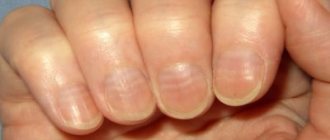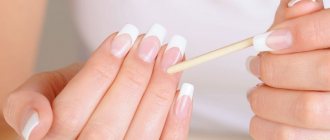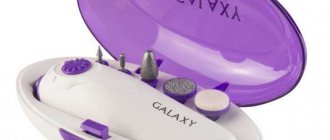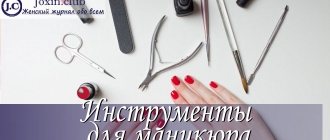A nail file is an indispensable manicure tool for every girl, and not just for a manicurist. It performs several functions at once: with a file you can remove the length of the nail plate, shape your nails, polish them to a shine, and lift the nail scales to improve adhesion between the artificial coating and the nail.
But when choosing such a simple, at first glance, tool, several questions arise at once:
- What material is better to choose a nail file from?
- What is abrasiveness and grit? What are they talking about?
- file shape. What is it for and which one is it intended for?
Well, let's find out.
Types of files by material
The first thing we encounter when choosing a nail file is the material from which it is made.
Disposable files
These nail files are made of polystyrene foam or multi-layer cardboard. The top is covered with tiny Teflon, quartz or granite chips. Disposable files are an ideal option for manicurists and beauty salons. From the name it becomes clear that they can only be used once. As a last resort, you can have a separate nail file for each client. Such files cannot be washed or sterilized; they deteriorate from moisture and high temperatures. But they are low cost, so one-time use is quite justified.
Set of classic nail files gray 100/180 g ParisNail 10 pcs/pack
Buff mini 100/180 white ParisNail 50 pcs
Set of nail files pink boat 100/180 g ParisNail 10 pcs/pack
Metal files
Reliable, versatile, durable. These files can be used for several years. Due to their low cost and long service life, this type of file has not lost popularity for several decades. However, experts do not recommend using them on the natural nail plate, especially if it is peeling and brittle. This can cause your nails to split even more. What are metal files used for? For working with thick nails in pedicure, as well as for correcting the shape and length of extended nails.
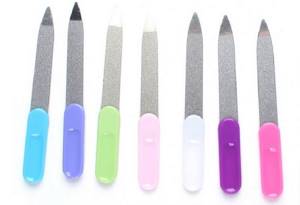
Glass files
Glass files allow you to carefully and accurately remove the length of the nail plate, give it the desired shape and not be afraid that your nails will begin to peel in the future. They are absolutely safe for natural nails. Glass files are resistant to high temperatures, so they can be sterilized in dry heat. When using, be careful not to drop this nail file, otherwise it may break.
Bohemia glass file, color 1202b, length 12 cm Solinberg
Bohemia glass file, colored 0902b, length 9 cm Solinberg
Ceramic files
Ideal for thin, brittle and peeling nail plates. These files are quite soft and do not allow natural nails to peel. They so neatly align the free edge of the nail plate that they even began to be called “healing”. This type of file is also suitable for treating the skin around the nails. But they are unlikely to be able to correct the shape of extended nails.
Files on a wooden base
Files on a wooden base are intended for pedicure. The base is rigid, so the files do not bend. At the same time, they are lightweight and very convenient to use. The abrasive is held in place by glue. Such files can be disinfected, so they can be used for individual use many times.
Medium wooden pedicure grater AT-251 Silver Star
Wooden grater for pedicure PF-932-W METZGER
Foot grater SFP 009 YOKO
Laser files
Laser files are a new product in the nail industry, which confidently occupies a leading position. These files are made of plastic or metal. Holes are made on them in the form of a diamond-coated pattern, which is applied with a laser. Laser files perfectly “seal” the edges of the nail plate, thereby preventing it from delaminating.
Laser file 445 Solinberg
Laser file 14.8 cm Planet Nails
Laser file 443 Solinberg
Electrical
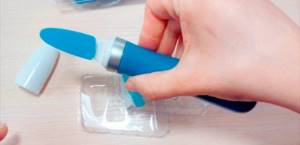
The cost of an electric file with several attachments is from 500 rubles. For example, the Scholl Velvet has only three attachments. The first is characterized by low abrasiveness and is intended for grinding. The second nozzle levels the surface and removes the remnants of the previous coating from the nail. And the third attachment of the Scholl file replaces the softest side of the buff - polishes the base to a natural shine.
Abrasiveness of nail files
In other words, abrasiveness is the hardness of the files, which is measured in grits. The more you grit, the softer the file; the less you grit, the harder it is. This indicator is usually indicated on the surface of the file or on the packaging. Quite often there are saw blades with two numbers, for example, 240/180. This means that one side of the file is softer and the other is harder.
Abrasiveness of artificial nail files
80-150 grit – hard files for artificial nails. These files are ONLY suitable for working on artificial nails. They can easily handle gel, acrylic, and tips. It is not recommended to use hard files on the natural nail plate.
Abrasiveness of files for extended and natural nails
150-240 grit – files of medium hardness. These files are suitable for both shaping and processing the length of the natural nail plate, and for processing extended nails.
Abrasiveness of files for preparing the nail plate
240-800 grit – buffs and polishers. Used to prepare the nail plate for artificial coating or nail extensions. They gently lift the scales of the nail plate, thereby improving the adhesion between the nail and the artificial material. They also allow you to remove gloss and unevenness of the nail plate.
Abrasiveness of nail polishing files
900-3000 grit – polishers. Polishers give nails a mirror shine. Mainly used for treating acrylic nails, but sometimes used for polishing natural nails.
Some additional information about laser, crystal and glass files
If you prefer a European manicure, then it is most convenient and correct to do it with laser files. They can be used to file away roughened side ridges. Professional instruments with the same abrasiveness are made for pedicures, treatment of corns and calluses. In general, this is the most convenient device for European manicure.
The surface on a laser file looks like a pattern on a metal one, but the grain size is so fine and comfortable that using the tool is a pleasure.
You can do the same experiment as with a metal file: run your treated nails over tights or skin. There won't be a single clue left. It is easy to smooth out and remove roughness and unevenness with a file.
The more often you use a laser file, the sooner the need for trimmed manicure will disappear: the skin gets used to the treatment, grows slower and more evenly. The file can be used to process both skin and nails.
Many customers leave their positive reviews after using glass, crystal and laser files. Try it too. This might be the tool you've been looking for.
Types of files according to shape
Files differ from each other not only in material and abrasiveness, but also in shape. Let's look at the main shapes of nail files that can be found in a store window.
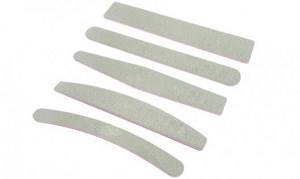
Straight (rectangular) shape
It is considered a classic type of file. It is used to give shape and length to nails in both manicure and pedicure.
Nail file wide 240/240 TNL ind/pack
Nail file Square 100/180 Kodi
Arc (boomerang, banana)
Most masters prefer this particular form of files, since it is believed that it is most convenient for filing the free edge of the nail plate. This shape allows you to shape the nails without twisting the clients’ hands while working. It is also great for beginners.
Mylar nail file boomerang 80/80 red OPTION
Nail file boomerang zebra 100/180 Planet Nails
Nail file boomerang-wide 100/180 zebra OPTION
Buff (grinder)
Buffs can be in the shape of a rectangle or parallelepiped. Its main task is to prepare the surface of the nail plate for applying an artificial coating.
Buff mini 100/180 red ParisNail 50 pcs
Buff mini 100/180 Green Monami 50 pcs
Set of mini sanding blocks “Mosaic” 2-sided IRISK 9 pcs
Block shaped file
This file is also a parallelepiped. Each of its sides has a certain abrasiveness. It is convenient due to its multifunctionality: it can be processed, sanded, and then polished the nail plate. But masters use it in their work quite rarely. This file is more suitable for home use.
And a few more popular file shapes among craftsmen that cannot be ignored:
- oval shape;
- dome (boat);
- diamond shape.
Set of classic nail files gray 100/180 g ParisNail 10 pcs/pack
Set of nail files pink boat 180/200 gr ParisNail 50 pcs/pack
Nail file pink boat 180/180 gr ParisNail
What else do you need to know about nail files?
It is important to remember that overgrown nails are not cut off with scissors or nippers, but only filed down. This will avoid microcracks and protect the edge of the nail from delamination.
In salons, to speed up the manicure procedure, the nail is actually first cut with clippers and then filed. This is only done if the nail is very long and filing will take a lot of time. The master processes the remaining length with a file. But if you are caring for your hands at home, it is better not to cut off the length at all, but to file off the edge of the plate without damaging it.
If your nails are thin, take a file of medium hardness, if they are hard and dense, you can choose a harder one. Please note that files from 220 grit and above are suitable for your own nails (not strengthened with gel or acrylic).
It is important to purchase only products from certified manufacturers: today there are many instruments on sale that are made using artisanal methods. Such products can cause serious harm to your nails and are generally dangerous to your health.
Rules for filing nails
In order not to harm the nail plate and the skin around it, you must follow a few simple rules:
- Do not file your nails immediately after taking a bath or shower. Wait for the nail plate to dry!
- Work with the file in one direction from the edge of the nail to the center. Avoid movements in different directions, as well as sudden impact.
- Use personal instrument only. Do not lend it to friends or relatives to minimize the chance of infection.
- Now you understand the abrasiveness of nail files. Use the one that suits your specific case.
- Grind with buffs.
- Polish your nail plate no more than once a week.
- After treating your nails and skin, use a moisturizing or nourishing cream.

Note!
How to properly do a manicure and apply artificial nail polish at home is described in detail in the article “How to apply gel polish at home?”
The ability to understand the types of nail files is a necessary skill for every girl. And even more so for every master. And to learn even more manicure secrets and become a real professional, take manicure courses at ParisNail school.
Buffs
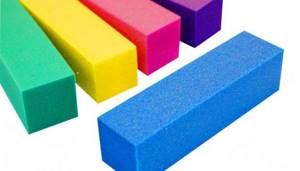
Buffs are indispensable for final leveling and adding shine. They are also called polishing files, although they often have the shape of a bar of various sizes.
Buffs can be two-, four- or six-sided. Each side is used in a specific operation, for example:
- The first is designed to level the surface of the plate. If you have wavy or brittle nails, you can file them no more than a couple of times a month.
- The second side will be needed when smoothing grooves and other irregularities. It has a slight rigidity, so you can use it 3-4 times a month.
- The soft third side of the buff is used when sanding a split nail as often as required.
- The fourth side has the lowest rigidity. It is designed to add gloss.
Buffs are not used for turning edges and corners.
How to save money on manicure?
Do you want to perfectly master the art of manicure from A to Z and never spend 2,000-3,000 rubles in a salon again? Then learn how to do a manicure yourself and save money, time and nerves!
Come to our School for an online course from top teacher Tatyana Svoboda “Manicure for yourself,” which can now be completed for only 499 rubles !
The teacher will tell you all about the technique of applying the coating, removing it, modern designs, how to strengthen your nails, and much more. You will become a real pro and will be able to create your dream nail designs, and, if you wish, monetize your hobby in the future!
Course bonuses:
We give all students a 15% discount on ready-made manicure starter kits, as well as a 5% discount on purchases at ParisNail and 15% on any other online course. Upon completion of the training, you will be issued an electronic certificate of completion of the course.
Manufacturers rating

Currently, the market for companies producing this tool is quite diverse. Therefore, you should carefully choose a nail file only from trusted companies.
It’s up to you to decide which company to choose the product, but the highest quality products are produced by the following brands:
- Scholl;
- Sinbo;
- Zinger;
- Mertz;
- Bohemia Glass;
- Velganza;
- Visage Studio;
- TNL Professional;
- Qvs.
The first company on the list is an American brand that specializes in the production of electric saws.
The second brand is a representative of Turkey. It produces entire manicure sets that allow you to change the attachments on the product. This allows you to make the nail device multifunctional.
The German brand Zinger produces manicure sets. All of the products are made of high-quality steel, which has gold or silver plating.
The Mertz brand is also representative of the German market. The cost of their products can be attributed to the average price category. The service life of such manicure tools is quite long.
The representative of the Czech market is the company Bohemia Glass. Basically, the brand specializes in the production of glass products. Many of the files have a working surface on both sides.
The Israeli brand Velganza produces laser files that can be used to remove peeling skin on the hands and feet.
The Russian company Studio Visage specializes in the production of manicure sets and various types of nail files. In their assortment you can even find disposable tools for performing manicures.
Another representative of the American market is OPI Products. The brand produces both professional tools and tools for home use. Their rulers make it possible to choose files with different degrees of hardness. This allows you to choose a product for different purposes.
The Korean brand TNL Professional produces professional cosmetics for nail care. Their products are quite durable and have a stylish and bright design. As a rule, products have two working surfaces.
The Qvs brand is representative of the Australian market. The products are made from high quality steel produced in Norway. The tools have a long service life.
Content
- What does European manicure mean?
- What is the difference between European manicure and classic manicure?
- Tools and materials
- Execution technology
- European manicure with coating
- Dry European manicure with a file
Once upon a time, European manicure was the only alternative to the classic edged manicure, but much has changed since then, and there are many more unedged types of nail treatments, which are less traumatic for the cuticle. Therefore, calling it unedged is no longer entirely correct - not everyone will immediately guess that we are talking about a European type of manicure.


